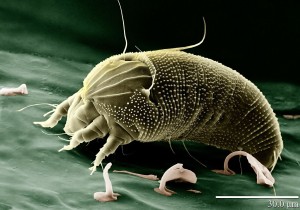
The overwhelming majority of people who are allergic to cats, suffer because of traces of proteins – especially two of them – Fel d 1 (a secretoglobin) and Fel d 4 (a lipocalin). These proteins are associated with the skin and saliva of a house cat.
Allergic to Cats? How You’re Exposed
Flakes of dead skin can be found on the fur. Now, a cat cleans itself by licking its fur. So if you let a cat lick you, you are exposed to both of the primary allergy-related proteins. That and two or three other minor protein allergens as well.
What About the Cat?
Humans aren’t the only creatures subject to allergies. Cats have them, too. As the cat is a source of human allergies, humans can be the source of a cat’s allergies, even if they aren’t the direct cause. How so?

Smaller than Mites
Resembling science-fiction monsters, dust mites (Dermatophagoides) live in human domiciles – most notably in carpet, bedding, and mattresses. These translucent, microscopic creatures produce waste droppings that contain even smaller bacteria. These bacteria produce endotoxins that directly produce the facial excoriation and other dermatitis symptoms of house cats.
Note: You might also enjoy Eight Correct Ways to Pet Your Cat
References:
- WebMD: Information on Cat Allergies
- Veterinary News: FAQs about house dust mite and storage mite allergies
- Research Gate: Which gram-negative bacteria lives in the gut of the house dust mite?
